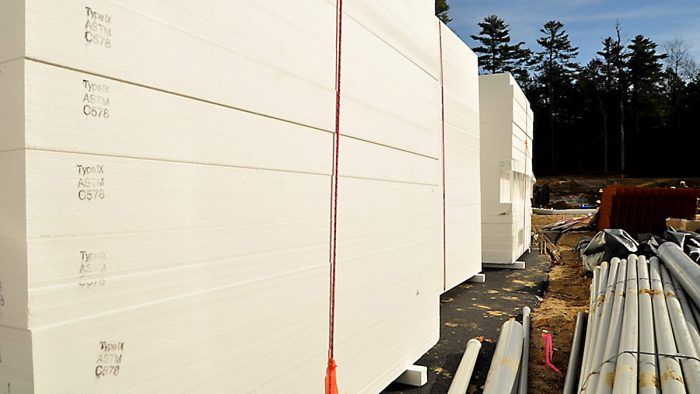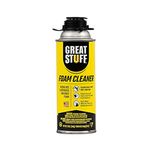Why Do Some Builders Avoid Foam Insulation?
R-value tells only part of the story; you also need to consider the environmental tradeoffs involved in choosing insulation.

Q: Some builders and designers shun certain types of insulation because of their potential to damage the environment. What are the environmental tradeoffs involved in selecting insulation and why are some builders “foam free” advocates?
A: Life was a lot simpler when we could select insulation solely on the basis of how effectively it stopped the flow of heat. The higher the R-value, the less heat would sneak through a wall or a roof and the more comfortable the occupants would be.
That’s still true. The R-value of any given insulation is an important consideration. Building assemblies with higher R-values require less energy to heat and cool, so some builders and designers lean heavily toward the types of insulation with the highest available R-values. This list includes several varieties of foam available in sheet form—expanded polystyrene (EPS), extruded polystyrene (XPS), and polyisocyanurate. In addition, there are two types of spray polyurethane foam—open- and closed-cell—that are applied as a liquid. They quickly cure into a solid mass and are often used in exterior walls and roofs.
Foam insulation tends to have relatively high R-values when compared to other materials. XPS, for example, has an R-value of 5 per in. when manufactured, and some types of closed-cell spray polyurethane foam have R-values of greater than 7 per in. All of these options look better than some of our old standbys, such as fiberglass batts with an R-value in the neighborhood of 3.5 per in.
Some manufacturers have been careless or misleading with their R-value claims, and there are building scientists who would like to junk the metric altogether. The R-value of polyiso declines in cold temperatures while other types of insulation show one R-value at the time of manufacture and another a few years down the road as the insulating gas dissipates, a phenomenon called thermal rift. So, there are certainly problems with relying on R-values too much. But at least it’s a place to start.
The issue is that R-value tells only part of the story. The choices we make on building materials have far-reaching effects on the environment, and many builders and homeowners now recognize that we can no longer afford to make decisions in a vacuum. The R-value of a particular type of insulation becomes one of several factors to consider, not the only factor. Other variables include the chemicals and raw materials that are used to make it, the amount of energy needed to manufacture it, which translates into its carbon impact, and whether it is toxic in the event of a fire.
Blowing agents give foam its lift
Foam insulation is made by injecting a gas into a liquid chemical mixture and then allowing the mass to cure into a solid. The gas is what’s called the blowing agent, and it creates tiny bubbles in the cured foam that define its thermal insulating properties. Different types of foam use different blowing agents, and each of them has a different impact on the environment, usually described as its global warming potential, or GWP. These values compare the impact of a blowing agent to that of carbon dioxide, a reference greenhouse gas with an assigned GWP of 1.
A common class of chemical blowing agents called hydrofluorocarbons has a relatively high GWP. For instance, an HFC used to make some types of closed-cell spray polyurethane foam, HFC-245fa, has a GWP of 1030. The blowing agent widely used to make XPS, HFC-134a, has a global warming potential of 1430—more than 1400 times that of carbon dioxide.
Newer types of blowing agents are available, such as a hydrofluoroolefin (HFO) called Solstice that is used in some brands of spray polyurethane foam as well as XPS. Honeywell, which developed Solstice, advertises an XPS board made with this chemical that has a GWP of less than 1. EPS, another form of rigid polystyrene insulation, also has a relatively low GWP of 7 because it’s made with pentane (a hydrocarbon) as the blowing agent.
Some builders will avoid foam insulation completely because of concerns over the blowing agent, but if the goal is to minimize the problem there is a range of choices with lower GWPs that is available.
Other concerns with foam insulation
Blowing agents aren’t the only thing that some builders object to. Spray foam insulation can off-gas unpleasant or unhealthy contaminants when it is mixed improperly on the job site (this is not an issue with rigid-foam panels made in a factory). Foam insulation is a petrochemical product, and when foam insulation burns it can release irritating or toxic fumes, including carbon monoxide. The horrific fire at the Grenfell Tower in London in 2017 is an example of what can go wrong.
Yet another issue is the embodied energy in various types of insulation, including foam. Embodied energy is the amount of energy it takes to make something, plus the energy it takes to produce the raw materials, transport the materials, and get the finished product to the site. Embodied energy and the carbon that it represents is playing an increasingly larger role in decisions about which building products to use and which ones to avoid.
A group in Canada called Builders for Climate Action produced a report in 2019 that detailed the carbon impact of various types of insulation. Foam insulation headed the list, beginning with the worst offender, extruded polystyrene blown, and followed by closed-cell polyurethane foam (HFC blowing agent), closed-cell foam blown with HFO, and EPS. Insulation with the lowest carbon impact included denim batts, wool, dense-pack cellulose, cork, hempcrete, and straw bale (in that order).
The difference is significant. XPS has more than five times the embodied carbon by weight than dense-pack cellulose, which is mostly recycled paper or cardboard. Mineral wool batts had roughly one-third the embodied carbon of XPS by weight, according to this research.
Weighing the pluses and minuses
Of course, there are many benefits to foam insulation. Its high R-value and, in the case of spray polyurethane foam, its usefulness in hard-to-insulate cavities, are big positives. Rigid foam is often used to insulate concrete slabs and foundation walls because of its compressive strength and its water resistance. Closed-cell spray foam is an air and moisture barrier, and it adds structural strength to assemblies in which it’s applied.
All of these factors tip the scales in favor of foam for some builders and in some situations. But for others, the environmental and health and safety downsides are of more importance. If you’re interested in a more detailed explanation of the foam-free point of view, take a look at the “Foam Fails” series posted at 475 High Performance Building Supply, a retailer of building products in New York.
Originally published on GBA.com.
Fine Homebuilding Recommended Products
Fine Homebuilding receives a commission for items purchased through links on this site, including Amazon Associates and other affiliate advertising programs.

Caulking Gun

Staple Gun

Great Stuff Foam Cleaner




